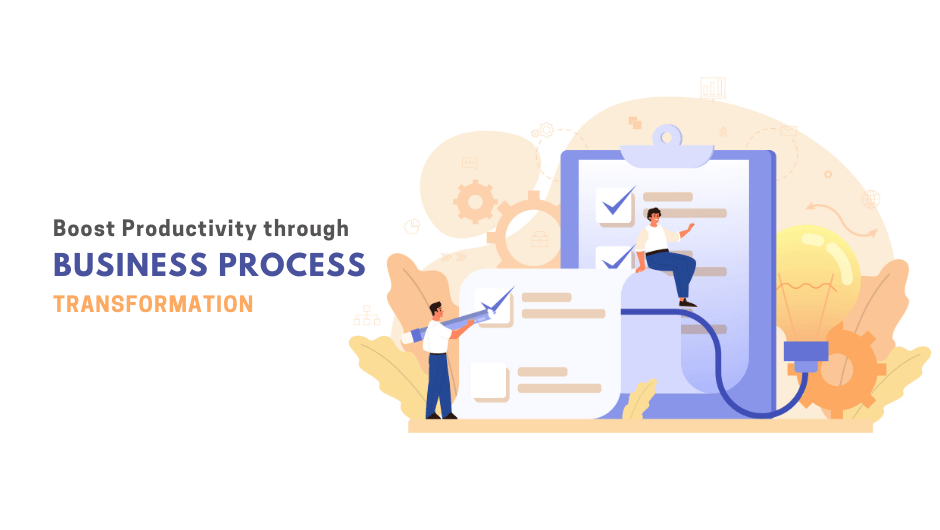Business Process Transformation: Complete Guide

According to IDC, two-thirds of the CEOs of Global 2000 companies say that they will have digital transformation at the center of their corporate strategy. Business Process Transformation comprises drastically modifying the process elements so as to meet new business aims and goals.
Generally, the new goals and objectives revolve around the new set of business process transformation implementation. Usually, companies engage in business process transformation when they have to make tremendous changes and amends in the pre-existing processes.
Using appropriate process transformation methodology, modernization of processes, incorporation of new technology, cost-cutting, and better integration of the core systems are ensured. Business process transformation is part of a wider prospect called business process management (BPM).

What is Business Process Transformation?
Business Process Transformation (BPT) describes the act of fundamentally modifying the set of actions needed to meet particular business goals. It comprises examining the series of steps that would be required to attain a specific goal. This aims to remove redundant, repeat or extra steps by automating as many actions as possible.
Compliance and risk regulations, along with the changes in the economy, generally drive business process transformation.
What are the Steps in Business Process Transformation?
The steps in Business process transformation are similar to the steps in business process management. The only difference is it attempts to make evident and more radical changes.
The steps of Business Process Transformation are as follows:
- Identify and figure out the goals of the Business process transformation
The very first step is to ask certain questions about your business. Do you primarily aim to upgrade the whole process systems? Or just incorporation of new technology is enough? Or do want to adapt and modify processes as per the new organizational structure? And finally, what exactly led you to need this change?
- Establish reference point metrics
Gather impressive relevant the data required to depict that your business process transformation is going to be successful. Think about everything from cost, error count, time and other measurable metrics.
- Involve all your stakeholders
Keep in mind to ask everyone who is somehow involved in the process about their perspectives; feedback on the current workflow and model, their loopholes or bottlenecks and what all do they expect from the new process?
- Process Mapping to reach the best-case scenario
Create a visual, understandable diagram of an ideal workflow comprising all the individuals and system tasks that occurs.
- Implement A/B testing of the processes
Use BPM tools effectively to design and generate a dummy process and check how it runs involving people and data.
- Observe and monitor
It is important to carefully monitor every single aspect of the new process in the initial stage. You can assign small teams at first to check the overall progress and make any changes that needed for the process to be successful.

Who Should Apply BPT ?
Any business facing the issues mentioned below must apply business process transformation techniques in their processes:
- A pre-existing process not meeting the business goals and demands.
- Observing significant number of errors in a process.
- Recently updated or upgraded the surrounding technology.
- Your existing corporate organization’s visions no longer making sense.
What is the Importance of Efficient Business Process?
Why do we need to transform a business process? An efficient business processes have the following major qualities:
- Customer-centered.
Customers are always the first for a successful business. Both internal and external processes affect the customers. Internal processes like accounting serve mostly the internal customers.
But they have a great impact on the external customers as well. For example, an inaccurate billing due to problematic tracking of labor hours affects external customers.
- Simple processes.
Simplicity simply means a reduction in the number of tasks in a process. It also minimizes the training costs, interruptions, redundancy, replication, and blunders.
Large corporations keeping all the processes is almost impossible. They can still simplify their processes as much as possible, so there’s no stacking, or piling up of huge tasks.
- Lesser business rules.
There are certain unavoidable rules that business needs to follow: Security, authorization, wellbeing, and environmental and ecological norms. Ample rules are to be followed by any business.
Some rules are present to the maintain quality and steadiness of a business. Others are for bureaucratic purposes and to serve personal interests. With each rule, a wide range of processes is increased, which increases both, the process costs and cycle time. For example, do you really need multiple signoffs for office expenditures?
- Clarity of roles and responsibilities.
Clarity of roles nurtures the responsibility and ownership of work. Without clear roles and responsibilities, people will tend to cut off from the work they don’t understand. And, create workarounds that make sense to them. With the evolution of business, the job roles tend to change.
These changes could be substantial particularly for major transformation initiatives. It becomes crucial to revisit every person’s role and responsibilities periodically.
- Smart Sequence of work.
Tasks which are streamlined bring efficiency to execution. An in-depth understanding of what is to be done helps sequencing the tasks appropriately. This optimizes the flow, thus minimizing the wait time.
- Perfect Alignment and Integration.
When there’s involvement of a lot of people from various departments or locations, there are chances of bottleneck creation within the process.
For instance, accepting student admissions even when all the seats are full would ultimately result in rising complaints and disputes. A student registration for a course is not complete until the student is placed in a class and payment is processed. This burdens the accounting department with extra work.
They need to monitor and analyze student assignments and have to make reverse payments if there is no space. Accounting and registration need to figure out how to coordinate their activities in the best way that the backlogs are minimized and no unnecessary work needs to be done.
These are the top qualities of a sound process that makes it effective and efficient. The interdependency of tasks and potential overlaps of work across an organization introduce complexity to processes.
Transform your operations, achieve your goals
with our expert BPM consulting.

What are the Major Challenges in BPT?
If we make any huge shift in the overall business perspective with business process transformation, then it is prone to produce various challenges that need to be resolved in order to succeed.
- Weak Sponsors Engagement
Throughout the entire process lifecycle, from commencement to progress and distribution, strong sponsorship is needed from a person who will not only excel in your requirements but also be persistent enough to wait for the results to manifest. It is often more than a challenge to complete the overall transformation process without strong sponsorship.
- Change Management Practices
Yet another challenge for effective business process transformation is change management practices. However inefficient and ineffective the old process might have been, there will always be people who will still like “the old way of doing things”. As part of the implementation process, a business process transformation, you will have to use suitable change management principles to bring everyone together.
- Challenges with Integration
Not choosing the right BPM platform, may cause you a big loss in the future. You may get restricted in whatever you can assimilate and integrate with other software. You will realize from the beginning itself that how challenging it becomes to link to different platforms.
- Missing Key Objectives
It is one of the big challenges in business process transformation. Most process transformation efforts aim only to digitize a process and have no significant effect on the process efficiency. You shouldn’t settle for just a dressed-up version of the old process. Always keep in mind your success parameters have a clear definition.
Conclusion
With business process transformation, mapping out new processes and bringing digital transformation to the processes that are outdated and have the need to be upgraded is super easy. Easy integrations and automated tasks, makes it the perfect platform that automate your processes in a way that revolutionize the way you work.
Business Process Transformation (BPT) describes the act of fundamentally modifying the set of actions needed to meet particular business goals.
It comprises examining the series of steps that would be required to attain a specific goal. This aims to remove redundant, repeat or extra steps by automating as many actions as possible.
The steps of Business Process Transformation are as follows:
- Identify and figure out the goals of the Business process transformation.
- Establish reference point metrics.
- Involve all your stakeholders.
- Process Mapping to reach the best-case scenario.
- Implement A/B testing of the processes.
- Observe and monitor.
The major challenges in business process transformation are:
- Weak Sponsors Engagement.
- Change Management Practices.
- Challenges with Integration.
- Missing Key Objectives.
Follow us on Facebook to know more about latest BPM Trends and News
Take Action Now and Make a Difference
Feel Free To Contact Us for Further Information







